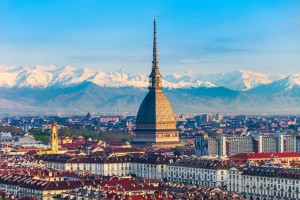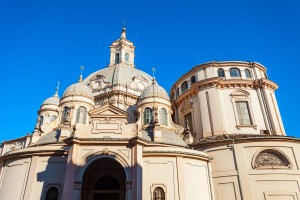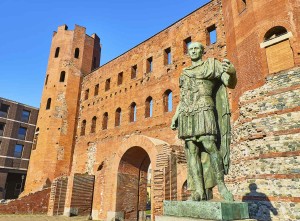Cars, football, industry – that’s pretty much Turin in a nutshell… or is it? Footie fanatics are drawn to the eternal rivals Juventus and Torino FC, the world-renowned car manufacturer was founded here in 1899, and many other companies, such as Kappa, Lancia and Lavazza, made their first steps in Turin. And then there is the Cathedral with the Shroud of Turin, one of the most important artefacts of Christian belief. In all actuality, Turin – located in north-western Italy, about 100 km each from the French and the Swiss border – is a fascinating city of arts with gripping history and a plethora of equally awe-inspiring sights. We invite you to join us on a tour through the capital of Piedmont.
From Roman military camp to the industrial boom

©Bigstock.com/saiko3p
By now you probably will not be surprised to hear that we first draw your attention to the history of Turin, which really is quite something. The name likely derives from “tau”, the Celtic word for “mountains”. Additionally, the Italian name “Torino” can be traced back to the folk-etymological expression for “small bull”, which is why Turin’s flag and coat of arms feature a bull. The Celtic-Ligurian Taurini tribe initially lived here before the Romans, who built a military camp around 28 BC. Its characteristic city structure with perpendicular streets remains present in the Quartiere Romano district. Around 5,000 inhabitants used to live inside Turin’s city walls back then.
Turin was ruled by the Lombards and the Franks after the fall of the Western Roman Empire before being conquered by the Dukes of Savoy in the late 13th century. They set in motion a full reconstruction of the city in the 15th century. Many of the famous gardens and palaces date back to this period, the university was founded in 1404, and Turin eventually even became the duchy’s capital. A 117-day siege of French troops during the War of the Spanish Succession was unsuccessful. After the unification of Italy Turin served as both its capital and seat of the king for four years. Then, the industrialisation resulted in an unprecedented boom. However, the industrial crisis of the 1980s put a devastating stop to this upswing. The population dropped significantly below one million where it has remained ever since.
The churches and basilicas

©Bigstock.com/saiko3p
Bevor becoming the Savoy capital in 1563, Turin had a predominantly medieval look. This was changed during the extensive transfiguration leading to, among other things, new road axes and the destruction or alteration of all 21 parish churches. Turin is still home to numerous world-renowned churches and basilicas you absolutely must visit. We recommend:
- Turin Cathedral: You probably will not be surprised by this first entry. After all, we briefly mentioned Turin Cathedral during our introduction. The Duomo di Torino is actually a rather plain building with a fairly unsophisticated design featuring classic Renaissance shapes, a marble façade and a campanile with baroque upper floors. We primarily mention Turin Cathedral because of the chapel behind its crossing, especially built for the Shroud of Turin and richly adorned. Looking to the heavens above you will be amazed by the imposing cupola. Despite having been debunked by science, many believers still venerate the linen sheet as the very sheet Jesus was buried in after the crucifixion.
- Basilica of Our Lady Help of Christians: The Virgin Mary appeared to the Salesian Don Bosco in a dream in 1844 or 1845 showing him the place of martyrdom of the Turinese saints Solutore, Ottavio and Avventore. Don Bosco had the Basilica di Maria Ausiliatrice built on this very spot. It was constructed during the second half of the 19th century and houses the relics of the saints as well those of its canonised constructor.
- San Lorenzo: Embedded rather inconspicuously in a row of palaces, this church on Piazza Castello looks like many buildings in this quarter. However, fascinating elements of Islamic architecture with skilful lighting tricks and imaginative shapes are hidden behind its façade.
- Superga: Take the cog railway to the Superga hill in the city’s east to reach the eponymous church at an altitude of 672 m. You can even see the Alps if the weather is right. Immerse yourself in the world of baroque art from the huge perrons to the equally impressive cupola.
Turin’s palaces and castles
We do not want to spend too much time on the castles and palaces of Turin. It is not for the lack of breathtaking beauty – quite the opposite! – but rather because we have already dedicated an entire World Heritage article to the Residences of the House of Savoy which we cannot recommend highly enough for more information. Five of these 14 residences are situated directly in Turin:
- Palazzo Reale
- Palazzo Madama
- Palazzo Carignano
- Castello del Valentino
- Villa della Regina
We must not forget Palazzina di Stupinigi, located about ten kilometres southwest of Turin and also part of this impressive UNESCO World Heritage Site. You most definitely should visit this baroque hunting seat, if only for its stunning architectural painting.
Even more sights in Turin

©Bigstock.com/Alvaro German Vilela
Still, we stay in Turin for now as the city of arts has so much more to offer. Here are some more essential sights:
- Porta Palatina: Thick city walls used to enclose Turin in Roman times. One of the three large city gates survived, likely in part due to serving as a prison in the 18th and 19th century after several conversions. Porta Palatina has been restored and reconstructed since. Two modern replicas of ancient statues flank the brick gate with its two tall watchtowers.
- Museo Egizio: This Turinese museum is solely dedicated to Egyptology and accommodates one of the largest collection of ancient Egyptian pieces in the world. Around 6,500 of the approx. 32,500 artefacts are on display. Numerous statues aside, Museo Egizio is particularly known for its extraordinary papyrus collection.
- Galleria Sabauda: Located inside the World Heritage palace Palazzo Reale, this picture gallery predominantly features Italian, French and Dutch art from the 15th to the 17th Marvel at works by Tintoretto, Rembrandt, Guercino, Buoninsegna and many others.
- Mole Antonelliana: This building was originally supposed to be a synagogue. When the Italian capital shifted to Florence during the second half of the 19th century and the costs exploded, all such plans were cancelled. The enormous tower with a height of 167.5 m is now regarded as one of Turin’s landmarks and is home of the National Museum of Cinema. The lift takes you up to around 85 m for a gorgeous view with a hint of the Alps.
- Lingotto building: Fiat’s Lingotto building used to be the largest automobile factory in the world. It even had its own test track for new cars on the roof. After the factory closed in 1982 during a devastating industrial crisis, the building was converted and modernised. It is now the home of a conference centre, a concert hall, a hotel, a shopping centre, and the art museum Pinacoteca Giovannni e Marella Agnelli with pieces from the collection of the Fiat couple. By the way, the test track on the roof still exists. You can check it out and even walk on it.
Turin has all sorts of highlights in store. Visit world-famous pilgrimage sites, be enchanted by ostentatious palaces and castles, and experience the city’s eventful industrial history up close. And yes, you absolutely should visit one of the awe-inspiring football stadiums. Enjoy your trip to the heart of Piedmont!